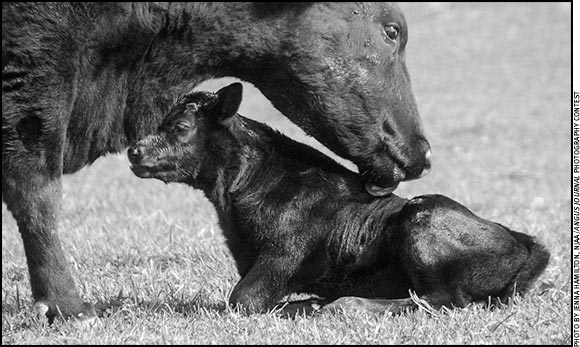HEALTH & NUTRITION...

Value of Vaccinations
Earlier vaccination on the ranch pays dividends down the line.
To producers who are thinking about cutting costs, Doug Ensley emphasized that administering vaccines is not the place to cut corners.
“Not vaccinating cattle is not a good idea for cattle health — especially as antibiotic use for treatment of sick cattle is becoming more limiting,” the veterinarian for Boehringer Ingelheim Vetmedica Inc. told attendees Feb. 2 at an NCBA Learning Lounge educational session during the 2017 Cattle Industry Convention & NCBA Trade Show in Nashville, Tenn.
He shared how disease prevention — through management protocols like vaccination — is a direct contributor to herd performance of both cow and calf, and thus, ultimately impacts profitability. Read more.
Precalving Vaccination Programs for Cows
Timing is important for efficacy of vaccines.
The best protection against disease in newborn calves is making sure they get an adequate amount of good-quality colostrum, containing antibodies against most of the pathogens they may encounter, soon after birth. If the dam has a chance to build a high level of antibodies before calving, she passes this temporary immunity to her calf via colostrum.
Vaccinating cows ahead of calving can help build peak antibody levels to make sure the cows’ colostrum contains the maximum amount of protective antibodies. Eugene Janzen, professor of production animal health at the University of Calgary, says the E. coli vaccines work well, but may not be as necessary as they have been in the past, especially in herds that no longer calve in confined or contaminated areas. Read more.
Giving CPR to a Newborn Calf
Veterinarian gives tips on calf resuscitation.
In a normal, easy birth, the calf is stimulated to start breathing as soon as the umbilical cord breaks or his face and nose are uncovered when the amniotic sac comes off his head.
Sometimes after a hard birth, a backward birth, or even a normal birth when the sac doesn’t break, the calf is without oxygen too long and can’t start breathing. If the cord detached during birth, he will die unless he starts breathing quickly. The calf may be limp, unconscious and have blue gums. At first glance you might think he’s dead, until you put a hand against the ribcage and feel his heart beating. Read more.
Know Your Requirements
Proper mineral nutrition is important to your cattle operation.
If you don’t first address the energy and protein requirements of your cattle, minerals aren’t going to matter, Beth Kegley, professor of animal science at the University of Arkansas, told her audience at the Cattle Industry Conference Feb. 1. Kegley spoke as part of the 24th annual Cattlemen’s College® in Nashville, Tenn.
One of the most complicating factors surrounding mineral nutrition in cattle production today is that mineral requirements at each stage of the production chain can be vague.
“We don’t really know what we don’t know,” she said. At a certain level, it will be apparent in the animal’s appearance that it isn’t doing well. Otherwise, and in most cases, the animal simply won’t be functioning to its full potential. “You’ll be leaving something behind.” Read more.
Texas Cattle Fever Ticks are Back with a Vengeance
Texans take steps to corral the spread of this devastating tick species.
Texas cattle fever ticks, which made Texas longhorns the pariah of the plains in the late 1800s, are once again expanding their range with infestations detected in Live Oak, Willacy and Kleberg counties, said Texas A&M AgriLife experts.
As of Feb. 1, more than 500,000 acres in Texas are under various quarantines outside of the permanent quarantine zone.
Pete Teel, Texas A&M AgriLife Research entomologist at College Station, said the vigilance and cooperation of regulatory agencies, namely the Texas Animal Health Commission (TAHC), the USDA and the Animal and Plant Health Service, in collaboration with the livestock and wildlife industries, are needed to detect, contain and eliminate cattle fever ticks. Read more.
Dewormer Dilemma
The right questions can lead to the right parasite-control program.
The benefits of deworming your cattle are well-known: increased weight gains and breeding efficiency, reduced pasture contamination, improved immune status and more, according to the Federal Drug Administration (FDA) Center for Veterinary Medicine. However, it’s not as easy to know which deworming product to use.
“To reap these benefits and reduce the risk of resistance, it’s critical to use the most effective product at the most strategic times,” said Doug Ensley, professional services veterinarian with Boehringer Ingelheim Vetmedica Inc. (BIVI). He recommends reviewing the following questions with your veterinarian. The answers will help you find the right parasite-control product for your operation. Read more.
Cows Need The Right Nutrition At The Right Time
Proper nutrition during each trimester of pregnancy benefits
both cow and calf.
“Take care of Mama” is a saying not to be taken lightly, at least not when it’s in reference to pregnant beef cattle, said Lee Dickerson, a nutritionist with Land O’Lakes Purina Feed LLC. Dickerson addressed attendees of the 2017 Cattle Industry Convention & NCBA Trade Show during an NCBA Learning Lounge educational session.
Dickerson explained that mounting research in the area of fetal programming and epigenetics — which refers to maternal events during the development of the fetus — is revealing that how the female is treated throughout gestation is crucial to the future reproduction of that female, as well as the future performance of her progeny.
“The brood cow is the only managed species where the industry plans on her to lose weight during gestation,” he said. “Maternal hunger — during green up, drought or winter — is the norm.” Read more.
Cattle Diseases: Common Conditions/Terms
Click here for a list of common conditions and terms related to beef cattle diseases, such as anaplasmosis, brucellosis, BVD, E. coli, IBR and others.
[Click here to go to the top of the page.]






